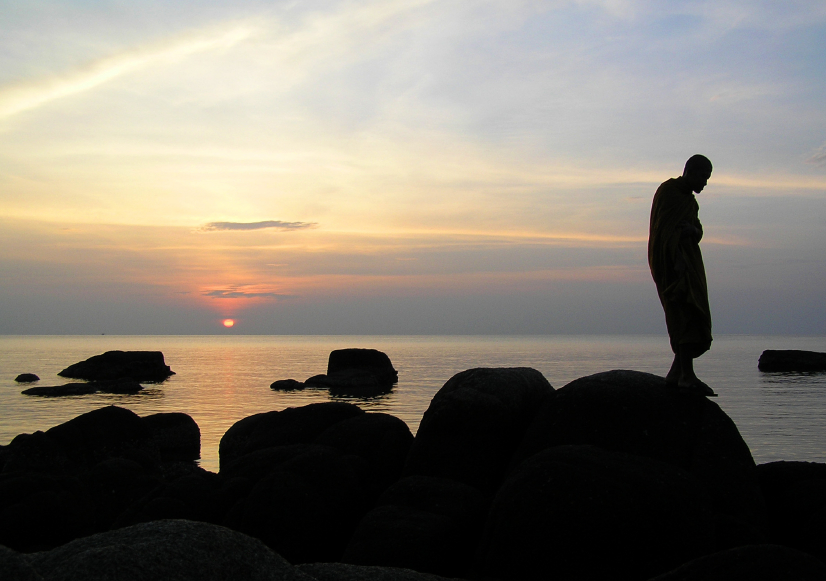The central metaphor of Buddhism is that of a path – a path that leads from Samsara to Nirvana, and a path that encompasses the cultivation of ethical conduct, meditation and wisdom.
Soon after I began to mediate relatively seriously, I was introduced to the mapping out of the path in terms of stages of meditation associated with the Theravadan tradition. Later I became acquainted with maps associated with other traditions. I can’t remember precisely what my expectations were at the beginning, but I think I was reasonably confident that 15 years later I would have zipped through a few jhanas (stages of meditation) and be well on my way to enlightenment.
Needless to say, it hasn’t turned out quite like that.
While I don’t doubt that I have gained much from doing various kinds of dharma practice, I would be hard put to answers questions like: How much progress have I actually made? Where exactly am I on the path?
One difficulty with thinking about progress is that different traditions map out the territory differently. For example, in the Theravadan tradition there are the seven purifications of Buddhaghosa’s Path to Purification, as well as the eight stages of jhana. In the Mahayana, there are the ten bhumis of the bodhisattva path and in Vajrayana there are the stages of the Lamrim Path, which are said to vary according to the motivation of the practitioner.
Even within related traditions, one teacher may say that a nimitta (sign) of bright light arises when is about to enter the jhanas, while another says that practitioners can enter the jhanas without seeing a nimitta. One teacher says that even those who have meditated regularly for many years are likely to need 3 to 6 months intensive, full time meditation to achieve shamatha or the first jhana (if they are lucky), and that without having achieved shamatha doing any kind of insight practice is pointless. Other teachers suggest that entering the first jhana is not really so hard or so rare, and that in any case one can begin simple insight practices after just a few days of shamatha practice. Some talk of enlightenment in this very life, some talk of it taking a multitude of lifetimes. It can all be quite confusing.
Teachers also often warn against thinking about progress at all, and, in particular they insist, I’m sure correctly, that hoping for or striving for a particular experience, sign or state of mind is a sure guarantee that it will not arise. Just relax, carry on carrying on and when the time is ripe what will arise will arise.
That is all well and good. But when one is presented with a mapped out path, it is difficult not to wonder where one is on the path and whether one is going in the right direction. And it does seem important to sometimes stop and think about whether the practices you is doing are getting you somewhere, or whether you are just going around in circles or treading water (sorry about the mixed metaphors).
Of course, if you are someone who has a guru in whom you have complete confidence, then this is not a problem at all. Such a guru should be able to tell you exactly where you are at and precisely what you need to do next. But the many people like me who have never felt that level of complete confidence in any teacher or have never met a teacher willing to be so directive need to grope their own way along the path.
Probably one of the most sensible and useful things about this I have heard came from Visu Teoh during a retreat in Hong Kong when he was asked the question “How do we know we are making progress?” I can’t remember his exact words, but they were something along the lines of: “Don’t worry about jhanas and such stuff, just observe yourself. Do you get angry less often? When something irritates are you better able to let go of the irritation? Are you more content and have fewer cravings? Do you feel happier and more peaceful?” This makes a lot of sense to me, because obviously the point of doing Dharma practice is not to have interesting mental experiences or enter particular states of mind for their own sake, but to reduce the power of negative mental factors such as anger, craving, self-centeredness and ignorance to condition one’s thoughts, speech and actions. I have since heard and read other teachers saying similar things.
But it is still not straightforward. If I look at myself, I am still overly attached to people and possessions. I still occasionally get angry. I still sometimes snap at people out of irritation. I still sometimes impulse buy, stuff into my mouth things I shouldn’t be eating, and do things because they give me pleasure without thinking about their effect on others.
I think I can say that such behaviours now occur less frequently than they used to, and I am certainly much more aware of them when they do occur. But then again, I am 15 years older (and maturer?) than I was when I started dharma practice. I am also retired and so much less stressed on a daily basis. It would be surprising if I wasn’t a bit calmer and less prone to react negatively to what comes up.
So what is my answer to: “Am I making progress?” Probably: “Yes, a bit,” but I couldn’t spell out the causes and conditions that have led to any progress. As for whether the question is worth asking, I think it is possible to find a middle way between the extreme of constantly worrying about whether the practices one is doing are “working” on the one hand and the extreme of never taking the time to sit back and consider whether one’s practices need to be refreshed, supplemented or modified on the other. I wonder whether others have thought on this.



Excellent piece, Graham. I think it’s a question every practitioner struggles with at one time or another, or maybe even constantly! I think we need to keep in mind that many, if not most, traditional paths laid out were meant for monks who did nothing but practice day in,day in. The Theravada paths certainly were intended for ordained people, and the Tibetan practices were largely aimed at monks and nuns as well. If all you do every day, 24/7, is practice, it does stand to reason that you should make some progress on that path. But for us laypeople, the path is necessarily less intense and so the results are more fuzzy. I’ve been told the same as you by many teachers – to measure our progress by how much more content, kind, compassionate and insightful we are, and this makes sense to me too. My expectations at the beginning were very very high, and are now much more realistic (lower), but that’s ok, because I’m not ordained and that’s my choice. Thank you for another thought-provoking article!
Thank you so much for this, Roberta. It’s good to be reminded that others sometimes face the same dilemmas and concerns.
I think there’s a case for throwing out the maps and just carrying on putting one foot in front of the other or – to get away from metaphor – watching one breath after the next. In the moment, with trust. I remember Vishu telling us the same in Australia, and I was disappointed when I got home after that first major retreat to find I was still snappy with the kids. 15 years later I remain unenlightened but I do experience more space in which to observe my negative reactions; this sometimes provides time to choose not to act on them. Small progress, but so appreciated. Like Roberta I’m not ordained, and that’s OK.
Thank for the comment, Gillian. I will try to forget about maps. I guess it is a very common experience to begin with expectations that are quite unrealistic, especially if one is not willing to devote one’s entire life to dharma practice.